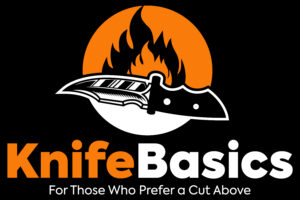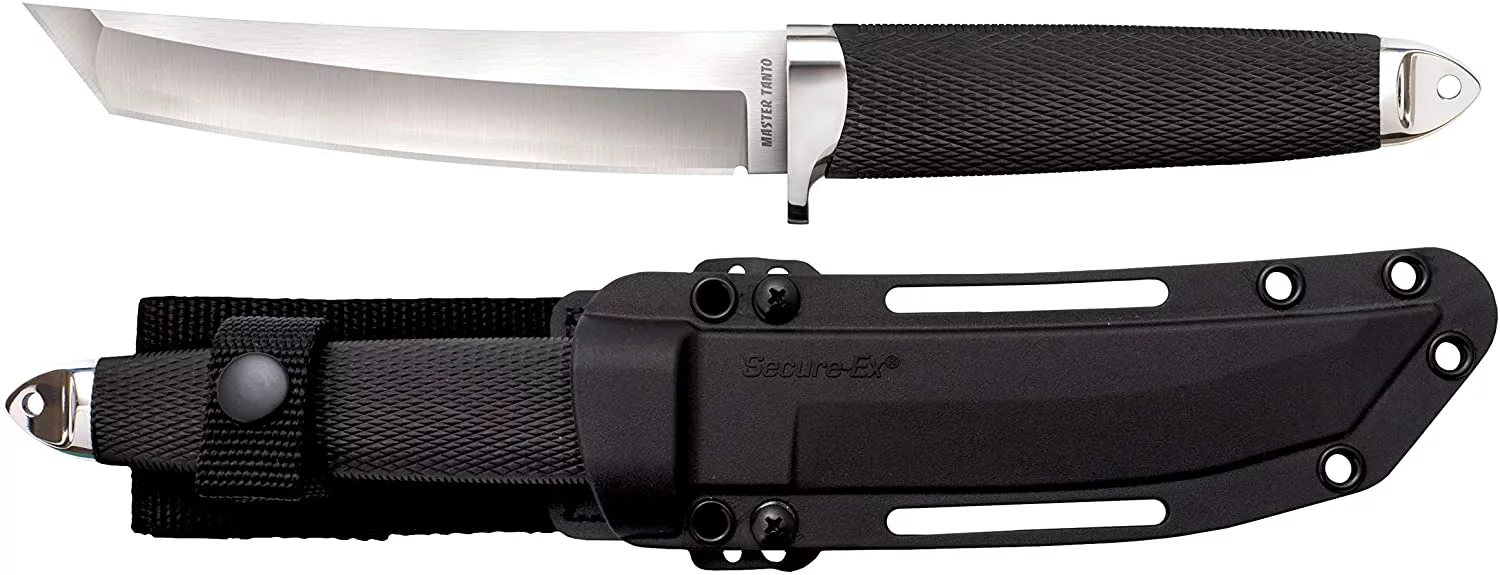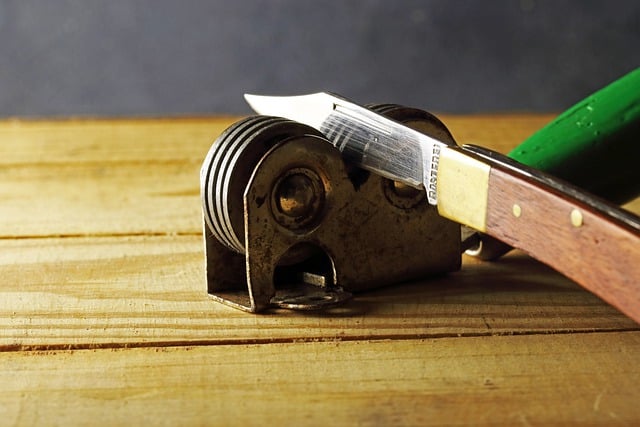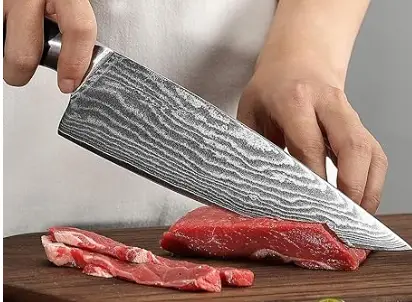Tanto blades are characterized by a sharp-angled tip, with a small curve or belly towards the main edge. The tip of the Tanto blades somehow takes the shape of a chisel point but is more pointy and doubled angle.
The original Tanto blade design has its origin in Japan and was meant for close-quarter combat. Depending on the manufacturer, they were produced following different heat treatment styles, designs, and details.
However, the blades were mostly used to make short swords, which served as knives because of their small size.
Tanto blades later evolved into Katanas and would be used during battles as stabbing weapons. Also, they were used for slash cutting when used in longer swords because they had a razor-sharp edge.
Over the years, Tanto blades were thrown out of the battlefield with the introduction of firearms.
However, the blade made a resurface recently in the knife-making industry, where they are being used to make folding knives.
Japanese version vs American version Tanto blades
As already stated, Tanto blades are originally from Japan and therefore, the Japanese Tanto blade version. Note that, both versions are excellent in what they do, but differ in their uses as discussed below:
American Tanto blade (Western Tanto blade)
The American version of the Tanto blade is also known as the western Tanto. The ColdSteel knife company largely popularized it. The fundamental feature of an American tanto is its secondary point.
At the secondary point, the blade takes a 45 degrees turn in a nearly flat manner to connect to the spine. The western tanto almost always features compound grinds, a hollow grind on the leading edge, and the smaller edge, typically a flat grind.
According to ColdSteel, the American Tanto style has a stronger tip which would be more suitable for piercing. The strong tip does not necessarily make it efficient for piercing, but it’s strong for tough piercing tasks.
One more thing to note about the design of the American Tanto is that the spine can be a trailing point, sheep’s foot, curving down like a drop point, or just straight. There is no clear rule on how the spine is aligned.
This shape gives the western tanto two points and two edges. So, does this categorize the Tanto blade as double-edged? The answer would be a yes and no, depending on the knife-making laws in your area.
What’s more, when sharpening Tanto blades, it is advisable to sharpen the edges separately to avoid damaging the secondary point. The edges serve different functions.
Between the two points, the front edge is better for in chiseling, box opening, and piercing. On the other hand, the edge between the secondary point and the handle is excellent in cutting and slicing.
The original Japanese Tanto blade
The traditional Tanto blade has a sharp-angled tip, with a small curve or belly towards the tip. The backbone of the traditional Tanto is made of a continuous edge, which curves near the tip to form a small belly that swoops up to meet the secondary point, and swoops up again to meet the primary point.
This shape gives it a strong classic tip and an excellent cutting edge. It is worth noting that the original Japanese Tanto took various features, shapes, and sizes too. Some of the most popular Japanese Tanto include the Hamadashi tanto and Aikuchi Tanto.
Advantages and disadvantages of the Tanto blade
Pros of the Tanto blade
Piercing
The triangular tip of the Tanto blades gives it the ability to pierce and penetrate objects better and without breaking compared to other knife blade designs.
Prying
Knife enthusiasts know that prying is never encouraged with pocket knives. However, things are different with Tanto pocket knives. The reinforced Tanto tip can help you pry successfully if that is the only option at hand.
Easy to sharpen
Tanto blades do not have a belly or a curve on the blade, and this makes sharpening very easy irrespective of the sharpening tools you are using.
Since the blade edges are almost straight, simple slides across a sharpening tool give you a consistently sharp edge.
Secondary tip
Tanto blades have a secondary tip, which is excellent for draw cuts and can also be used as a quasi-chisel. What’s more, the tip adds to the aesthetics of the knives.
Cons of Tanto blades
Sacrifices the cutting ability
The flat edges of Tanto blades reduce its cutting ability. Slicing through objects with a blade without a belly is not easy; this may force you to shift to other types of knife blades.
Tedious sharpening process
Tanto blades have two edges that should be sharpened separately; therefore, it takes you more time and energy to sharpen, which may be seen as tedious.
The good news is it is easy to get a consistent edge with Tanto knives because the blades do not have curves or angles.
Tanto blade uses
Recently, tanto blades have been hugely adopted in EDC knives; however, they are more versatile and can be used for various roles. Here are some of the best uses for tanto blades
- Piercing and puncturing: Due to the tanto’s strong tip, it is highly effective in piercing. Piercing is enhanced by the type of grind on the secondary edge. A sabre grind, for example, would be strong but not so sharp.
- Scrapping: the chisel edge of the Tanto is a great tool for scraping stickers and labels off surfaces
- Self Defense: The traditional Japanese tanto blade is great for self-dense. The American tanto is also great for self-defense and close-quarter combat. The tip enables it to be perfect for stabbing, while the edge cuts cleanly. It was designed to be an effective armor piercer.
- The tanto is also good for slashing tasks; the blade has a straight edge that lends it well for this purpose. A hollow grind on the cutting edge will greatly improve its slicing and slashing performance.
Tanto vs other knife blades
Tanto vs Drop Point Blades
Tanto and Drop Point blades are very similar in use scenario and used to make lots of EDC knives, with the main difference being the tip area.
A drop point blade is extremely versatile and can be used for almost all scenarios. The shape of a drop point features a smooth curvature on the spine that drops towards the tip.
A Drop Points offers a variety of designs and grinds to choose from, giving it much more versatility and flexibility over the tanto blade.
In terms of performance, they can be used for the same functions, but with tanto shining in piercing and drop point performing better in everyday utility tasks.
Tanto vs Reverse tanto
The main difference between the standard Tanto and Reverse Tanto is the geometry of the area near the tip. The front edge of the reverse tanto sweeps to the back and it is not sharpened.
Following its design, reverse tanto performs better in slicing tasks than the modern Tanto, as it features a belly on the leading edge.
A reverse tanto is also stronger as the spine is one solid piece of uniform thickness that is not sharpened on end, avoiding areas of weakness around the tip.
Are tanto knives good?
When it comes to deciding on the best knife blades, there is no good or bad; it all depends on the knife’s function.
Law enforcement officers find Tanto blades very useful. At the same time, other people buy Tanto knives because of their incredible design.
How to sharpen a tanto blade
The best way to sharpen a tanto is to treat the two edges as two different knives. You will need to sharpen each edge individually before proceeding to the next one.
The most important thing to observe is the transition point of the edges. You need to be careful not to round it as this will change the shape of the tanto blade.
Here is a beautiful Cold Steel San Mai Tanto worth checking out.



